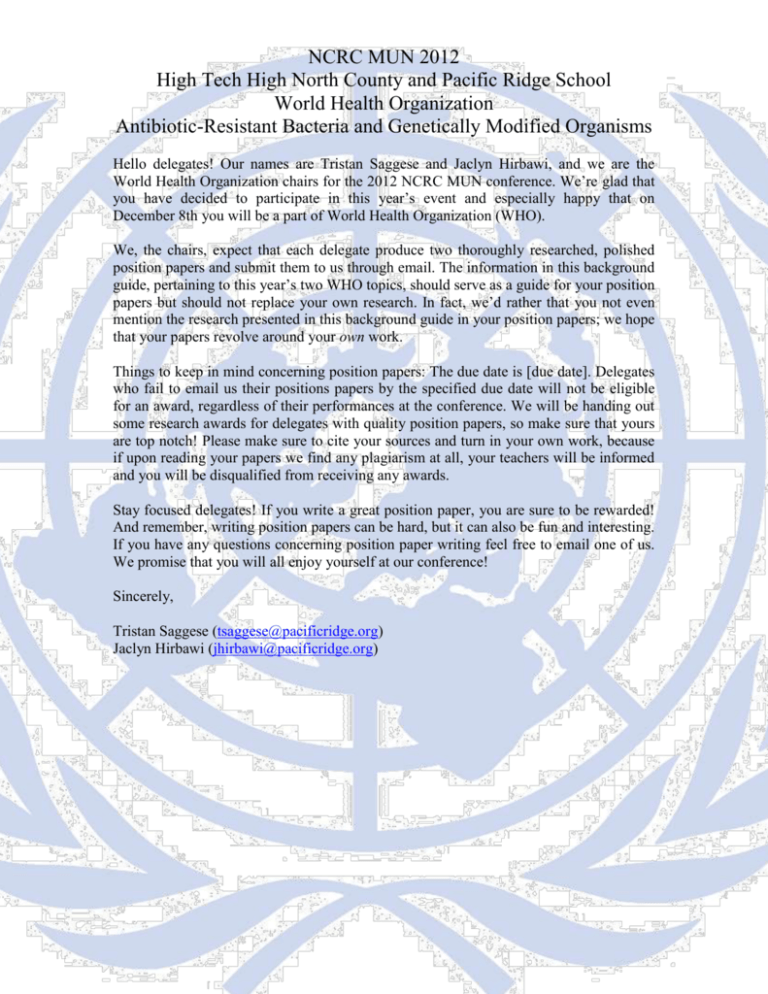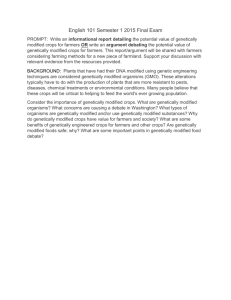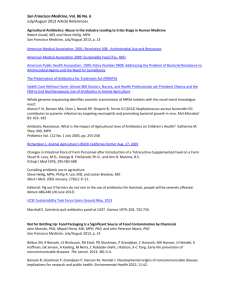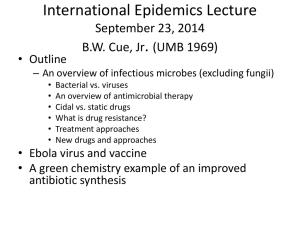NCRC MUN 2012 High Tech High North County and Pacific Ridge
advertisement

NCRC MUN 2012 High Tech High North County and Pacific Ridge School World Health Organization Antibiotic-Resistant Bacteria and Genetically Modified Organisms Hello delegates! Our names are Tristan Saggese and Jaclyn Hirbawi, and we are the World Health Organization chairs for the 2012 NCRC MUN conference. We’re glad that you have decided to participate in this year’s event and especially happy that on December 8th you will be a part of World Health Organization (WHO). We, the chairs, expect that each delegate produce two thoroughly researched, polished position papers and submit them to us through email. The information in this background guide, pertaining to this year’s two WHO topics, should serve as a guide for your position papers but should not replace your own research. In fact, we’d rather that you not even mention the research presented in this background guide in your position papers; we hope that your papers revolve around your own work. Things to keep in mind concerning position papers: The due date is [due date]. Delegates who fail to email us their positions papers by the specified due date will not be eligible for an award, regardless of their performances at the conference. We will be handing out some research awards for delegates with quality position papers, so make sure that yours are top notch! Please make sure to cite your sources and turn in your own work, because if upon reading your papers we find any plagiarism at all, your teachers will be informed and you will be disqualified from receiving any awards. Stay focused delegates! If you write a great position paper, you are sure to be rewarded! And remember, writing position papers can be hard, but it can also be fun and interesting. If you have any questions concerning position paper writing feel free to email one of us. We promise that you will all enjoy yourself at our conference! Sincerely, Tristan Saggese (tsaggese@pacificridge.org) Jaclyn Hirbawi (jhirbawi@pacificridge.org) NCRC MUN 2012 High Tech High North County and Pacific Ridge School World Health Organization Antibiotic-Resistant Bacteria and Genetically Modified Organisms Topic A: Antibiotic-Resistant Bacteria: Antibiotics play a fundamental role in preventing and curing illness and disease created by bacteria and bacteria-related organisms. Typically, when a human or animal develops a disease, one method of treatment is an antibacterial, or antibiotic, which effectively kills or hinders the growth of a given bacteria. Increased use or misuse of certain antibiotics, however, has resulted in bacteria resistant to antimicrobial drugs. Classified as antibioticresistant bacteria, these organisms can survive and even thrive on the very introduction of antibiotics targeting them. Previously curable illnesses like gonorrhea, tuberculosis, and pneumonia have become difficult to treat with common drugs. In fact, some bacteria known as multi-resistant organisms (MROs) are invulnerable to many or all of the drugs used to cure such diseases. As a result, doctors are left with no other viable option but to use experimental drugs that are yet to be proven effective or safe. Today, “approximately seventy percent of infection-causing bacteria are resistant to one or more commonly used drugs” (Todar 1). By nature, as the number of antibiotic resistant bacteria increases, our antibiotic pool decreases. Consequently, if preventative measures are not taken, antibiotic resistant bacteria could bring “the end of modern medicine as we know it” (Moisse 1). Signs of Antibiotic Resistance: The first antibiotic, Penicillin, which treats Tuberculosis, was discovered by Alexander Fleming in 1928. This discovery led to an age in which antibiotics ruled. Soon after its discovery, Penicillin and other antibiotics became a standard remedy for previously incurable bacteria-engendered illnesses and infections. Initially, drugs like Penicillin, Streptomycin, Chloramphenicol and Tetracycline were almost totally effective. In 1946, however, some resistance to Penicillin, in strains of Staphylococci, was discovered. Today, it’s assumed that almost “every known bacterial pathogen has developed resistance to one or more antibiotics in clinical use” (Todar 2). Antibacterial resistance develops in a variety of ways. It is important to keep in mind that evolutionarily it is only natural that some bacteria develop resilience to antibiotics. Nevertheless, human misconduct and misuse of antibiotics has catalyzed the growth of drug resistant bacteria. In the United States, for example, farmers often treat their animals’ food with antibiotics to ensure that they are immune from microbes--because of these farmers’ actions, antibiotics are often present in beef, cattle, pigs, and poultry. These antibiotics eventually runoff from animals’ housing facilities and feeding lots, tainting groundwater and streams, stimulating the growth of drug resistant bacteria, and finding their way into public water system. Moreover, careless use of antibiotics in farm animals causes antibiotic-resistant bacteria to grow in livestock and people who consume NCRC MUN 2012 High Tech High North County and Pacific Ridge School World Health Organization Antibiotic-Resistant Bacteria and Genetically Modified Organisms them. Typically, farmers place Antibiotic additives in their animals’ food to prevent (but not cure) the animals from acquiring bacteria-related illness. The frequent, improper use of antibiotics for preventative measures increases the likelihood of the rise of drug resistant pathogens. These new microbes replace once-curable bacteria and make diseases resistant to antibiotics in infected animals and humans. Often times, bacteria resistant genes are used to mark specific “genes of interest” in GMO’s (Todar 4); the improper removal of these genes promotes their spread and growth into other microbes in the environment, further spreading drug-resistant bacteria. The indiscriminate use of antibiotics in medical situations in which these drugs are of little or no need increases their circulation, increasing drug resistant bacterial growth further still. Irresponsible prescriptions of drugs by doctors and health officials has been a major contributor to the rise of bacteria with resistance to certain antibiotics. To cope with antibiotic resistant bacteria, new antibiotics are constantly being developed and implemented; the problem continues to escalate in that already antibiotic resistant bacteria have begun also to develop resistance to these cures to disease. For example, in 1959, after Staphylococci was discovered, scientists developed Methicillin to replace the now ineffective penicillin. Only two years after the drug was tested, Methicillin-resistant bacteria were discovered. Despite these efforts, the crisis of drug resistance continues to worsen as more bacteria become immune to our antibiotics. Past UN Action The international problem of antibiotic-resistant bacteria has only recently begun to be addressed with the urgency and care that it rightfully demands. In 2001, WHO released the “the WHO Global Strategy for Containment of Antimicrobial Resistance” whose goals were the following: “reducing the disease burden and the spread of infection; improving access to appropriate antimicrobials; improving use of antimicrobials; strengthening health systems and their surveillance capabilities; enforcing regulations and legislation; encouraging the development of appropriate new drugs and vaccines” (World Health Org. 2). The good intentions enunciated in the plan, however, are yet to be completely fulfilled. More recently, in 2011 on April 11, the World Health Organization announced “Antimicrobial Resistance” as the topic for 2011’s World Health Day. On this special day, WHO issued “an international call for concerted action to halt the spread of antimicrobial resistance” and recommended “a six-point policy package for governments” (www.WHO.int). The World Health organization’s most recent actions reiterated the importance of the growing issue of drug resistant bacteria and, once again, brought the issue to the public’s eye. Now WHO is focusing its efforts on policy guidance, support for surveillance, technical assistance, knowledge generation and partnerships, including thorough disease prevention and control programmes; essential medicines quality, supply and rational use; infection prevention and control; patient safety; laboratory quality assurance (www.WHO.itr). Despite the mentioned UN activity, NCRC MUN 2012 High Tech High North County and Pacific Ridge School World Health Organization Antibiotic-Resistant Bacteria and Genetically Modified Organisms the issue of antibiotic-resistant bacteria still looms and needs to be addressed with more specific goals and aggressive implementation efforts. Possible Solutions When brainstorming solutions, it is necessary that delegates keep in mind the ways in which antibiotic-resistant bacteria originate. The “Signs of Antibiotic Resistance” section of this guide briefly details several, but not all, of these reasons. It is suggested that delegates research further the causes of drug-resistant bacteria to better prepare themselves to write a position paper on the topic. Possible solutions to keep in mind are searching for new antibiotics--including methods to replace old, ineffective treatments/cures and replenish the deteriorating pool of useful drugs on the market; stopping the use (and growth) of antibiotics for preventative measures on farms; and stopping unnecessary prescriptions and distribution/circulation of antibiotics. Questions to consider: 1. What viable alternatives to antibiotics might this committee consider in its endeavor to solve the problem of drug resistant bacteria? 2. What immediate and long term precautions should be taken to slow the growth of antibiotic resistant bacteria? NCRC MUN 2012 High Tech High North County and Pacific Ridge School World Health Organization Antibiotic-Resistant Bacteria and Genetically Modified Organisms Works Cited "Antibiotic Resistant Bacteria." Home. 2012 State Government of Victoria, n.d. Web. 12 Sept. 2012.<http://www.betterhealth.vic.gov.au/bhcv2/bhcarticles.nsf/pages/Antibiotic_resistan t_bacteria>. Todar, Kennath. "Bacterial Resistance to Antibiotics." Bacterial Resistance to Antibiotics. N.p., n.d. Web. 12 Sept. 2012. <http://textbookofbacteriology.net/resantimicrobial_3.html>. Moisse, Katie. "Antibiotic Resistance Could Bring ‘End of Modern Medicine’." ABC News. ABC News Network, 16 Mar. 2011. Web. 12 Sept. 2012. <http://abcnews.go.com/blogs/health/2012/03/16/antibiotic-resistance-could-bring-endof-modern-medicine/>. "World Health Day: April 7, 2011." WHO. N.p., n.d. Web. 12 Sept. 2012. <http://www.who.int/world-health-day/2011/en/index.html>. Stamm, Professor W., Professor ML Grayson, Professor L. Nicolle, and Dr. M. Powell. "WHO Global Strategy for Containment of Antimicrobial Resistance." (2001): 1-99. 2001. Web. 12 Sept. 2012. <http://www.who.int/drugresistance/WHO_Global_Strategy_English.pdf>. "Antimicrobial Resistance." WHO. © WHO 2012, n.d. Web. 12 Sept. 2012. <http://www.who.int/mediacentre/factsheets/fs194/en/>. NCRC MUN 2012 High Tech High North County and Pacific Ridge School World Health Organization Antibiotic-Resistant Bacteria and Genetically Modified Organisms Topic B: Genetically Modified Organisms Genetically modified organisms (GMOs) are organisms whose genetic material (DNA) has been altered in a way that does not occur naturally. Scientists can use biotechnology to alter the genetic makeup of organisms such as animals, plants, and bacteria. The purpose of Genetically Modified Organisms is simply to improve the lives of humans, specifically farmers and everyday consumers. For example, ordinary crops are genetically modified to increase yields, protect crops from insects and disease, and increase crops’ tolerance to heat, drought, and other environmental stress. In addition, crops are frequently genetically modified to optimize their benefits to consumers by increasing the amount of protein and healthy oils they provide. Moreover, the use of genetically modified seeds can have environmental benefits that help reduce agriculture’s impact on the land, including soil and energy conservation and minimizing the use of herbicides. Common genetically modified crops currently cultivated include soybeans, corn (maize), rice, cotton, papaya, tomatoes, canola, potatoes, and sugar cane. As of late, scientists are conducting tests and comprehensive research to assess the safety of Genetically Modified animals; thus far, however, no GM animals have been approved for human consumption. Many of the crops presently being cultivated are used extensively in the production of processed foods (for example, corn, soybean and rapeseed oils) or are staples in the diets of people around the world (for example, rice and potatoes). Since labeling and transparency standards for GMOs differ among nations, the usage of GMOs is unregulated. Many opponents of GMOs, especially in European countries and North America, have raised suspicions regarding their safety and implementation. Most of GMOs challengers’ concerns relate to allergenicity, gene transfer inside the human body, and outcrossing of GM genes into wild species, all of which are said to be potential results of GMOs. The World Health Organization recently declared that no allergenic repercussions have resulted from GM foods currently on the market. Furthermore, the WHO deemed the possibility of gene transfer into the human body as a result of GMO consumption relatively low. Issues concerning outcrossing, the practice of using unrelated genetic material into a breeding line, remains hotly contested, and most concerns relate to “the capability of the GMO to escape and potentially introduce the engineered genes into wild populations; the persistence of the gene after the GMO has been harvested; the susceptibility of non-target organisms (e.g. insects which are not pests) to the gene product; the stability of the gene; the reduction in the spectrum of other plants including loss of biodiversity; and increased use of chemicals in agriculture” (WHO). However, the WHO surmises that the probability of horizontal outcrossing is relatively low as well. However, all GM crops, as well as GM foods produced by these crops, must undergo strict assessments to test their safety for human consumption. Therefore, all GM crops and foods currently available on the international market have passed risk assessments. Furthermore, there are different assessments undertaken to test whether NCRC MUN 2012 High Tech High North County and Pacific Ridge School World Health Organization Antibiotic-Resistant Bacteria and Genetically Modified Organisms GM crops are safe to grow and whether GM foods are safe to eat: some crops are approved for animal feed but not for human consumption. The World Health Organization (WHO), as well as many other international, regional, and national health monitoring bodies, has concluded that crops and foods that pass these tests are not likely to present risks for human health and can be considered safe for human consumption. Moreover, the WHO has reported that there have been no reliably documented effects on human health resulting from consumption of GM foods by the general population in the countries where they have been approved. However, it is important to note that, in regard to national regulations for GMOs, different nations have different standards of regulations and not all nations regulate GMOs. Humans have been altering the genomes of plants and animals for thousands of years through artificial selection (more commonly known as breeding). From the domestication of wild plants in prehistoric times to the relatively recent creation of new species such as the loganberry (a cross between a raspberry and a blackberry), humans have always sought to alter natural selection to better their own lives. However, genetic modification is different. Artificial selection had been previously confined to natural occurring varieties that were close enough in genetic makeup to mix traits. Today, genetic modification allows genes from one species to be spliced into organisms in another species, often in circumstances previously impossible. The first commercially grown genetically modified food crop was a tomato created by California company in the early 1990s called the FlavrSavr. It was approved for commercial production in 1992, and was genetically altered so that it took longer to decompose after being picked. In 1994, the first European genetically engineered crop, tobacco, was approved in France. Initially, genetic modification was introduced to improve crop protection, but recently benefits to consumers have also been highlighted Today, GM crops are currently planted in twenty-nine countries. The dominant crops being cultivated are soybean and cotton, and the dominant traits are herbicide tolerance and insect resistance. Most of the cultivation occurs in the Americas, but recently there has been a large jump in GMO cultivation in Southeast Asia. Between 1996 and 2009, almost half (46 percent) of the global hectarage of GM crops was planted by developing countries, and of the estimated 14 million farmers who planted GM crops, 90 percent (13 million) were small resource-poor farmers. Corporations play a larger role in biotechnology and GM crops than in any other agricultural sub-sector. As GM seeds are developed in laboratories, the corporations that develop these new seeds own rights to them, and farmers must purchase these seeds from the corporation that owns the rights. As such, companies like Monsanto and Sygneta that develop new seeds also control what crops and traits are produced. There have been criticisms that the GMO industry is too profit-driven and that its actions do not accede with its claims of creating food security and improving people’s lives. Many important crops, such as pulses, vegetables, and fodder, and certain traits, such as drought- and NCRC MUN 2012 High Tech High North County and Pacific Ridge School World Health Organization Antibiotic-Resistant Bacteria and Genetically Modified Organisms aluminum-tolerance, are still almost entirely neglected, even though they may be the most useful to developing nations Past UN Action The joint FAO-WHO body, the Codex Alimentarius, is perhaps the most authoritative reference for global food safety standards. Established in 1961, the Codex has established standards of food safety that are consistent from nation to nation, and its role as a coordinating mechanism for developing food standards is unquestioned. No modern international or regional body would consider developing such standards outside the Codex mechanism. From 1999-2008 the Codex Alimentarius Commission (CAC), established an Intergovernmental Task Force on Foods Derived from Biotechnology to consider the health and nutritional implications of such foods. The Task Force established a list of available analytical methods for the detection or identification of foods or food ingredients derived from biotechnology, and indicated the performance criteria and status of each method. However, despite addressing the labeling of GM foods at each meeting, the Task Force was unable to reach a conclusion on this topic. In 2000, with assistance from the WHO, the FAO established the Cartagena Protocol to the Convention on Biological Diversity, the main international agreement in relation to GMOs. It covers the transboundary movement, transit, handling and use of all GMOs (except pharmaceuticals) that may have adverse effects on the conservation and sustainable use of biological diversity. It also addresses risks to human health and allows for standard-setting in relation to the handling, transport, packaging and identification of GMOs. The FAO and WHO have also organized several expert consultations on GMOs, in order to keep the global community as well-informed as possible. Moreover, clauses pertaining to GMOs have been included in the Technical Barriers to Trade (TBT) and the Sanitary and Phytosanitary (SPS) Agreements of the World Trade Organization, and the International Plant Protection Convention (IPPC) of the FAO. As a global issue that is ever changing, more detail and factors need to be addressed in a future international agreement. NCRC MUN 2012 High Tech High North County and Pacific Ridge School World Health Organization Antibiotic-Resistant Bacteria and Genetically Modified Organisms Questions to consider: 1. What role can GM crops play in development, especially sustainable development? 2. What are the ethical, environmental, and health concerns regarding GM crops and how can these be addressed? 3. Should the WHO (and/or FAO) regulate for what purposes crops may be genetically modified? If yes, what guidelines should be established? 4. What is the impact of GM crops on the agricultural sector of the economy and of the economy overall, both national and global? NCRC MUN 2012 High Tech High North County and Pacific Ridge School World Health Organization Antibiotic-Resistant Bacteria and Genetically Modified Organisms Work Cited 1. "The Adoption of Genetically Modified Crops: Growth Areas | The Economist." . The Economist, 23 Feb. 2011. Web. 10 July 2011. <http://www.economist.com/blogs/dailychart/2011/02/adoption_genetically_modified_cr ops> . 2. Aldred, Jessica. "Worldwide Increase in GM Crops, Report Shows." The Guardian 13 Feb. 2008. 13 Feb. 2008. Web. 19 June 2011. <http://www.guardian.co.uk/environment/2008/feb/13/gmcrops.food>. 3. Fresco, Louise O. "Genetically Modified Organisms in Food and Agriculture: Where Are We? Where Are We Going?" Conference on Crop and Forest Biotechnology for the Future. Falkenberg, Sweden. 16 Sept. 2001. Address. 4. "Genetically Modified Crops: Most Common." Healthy Eating Politics: Alternative Information About Diet and Health. Web. 10 July 2011. <http://www.healthy-eatingpolitics.com/genetically-modified-crops.html>. 5. Phillips, T. (2008) Genetically modified organisms (GMOs): Transgenic crops and recombinant DNA technology. Nature Education 1(1) 6. Randell, Alan. "Codex Alimentarius: How It All Began." FAO. United Nations. Web. 10 July 2011. <http://www.fao.org/docrep/v7700t/v7700t09.htm>. 7. United Nations Environment Programme. "Genetically Modified Crops in Africa." The Encyclopedia of Earth. 13 Apr. 2007. Web. 10 July 2011. <http://www.eoearth.org/article/Genetically_modified_crops_in_Africa>. Updated 17 April 2011 8. United Nations. Food and Agriculture Organization. Committee on Agriculture, Twenty- second Session. FAO International Technical Conference on Agricultural Biotechnologies in Developing Countries: Options and Opportunities in Crops, Forestry, Livestock, Fisheries, and Agro-industry to Face the Challenges of Food Insecurity and Climate Change. Rome, 2010. Print. 9. United Nations. Food and Agriculture Organization, World Health Organization, and World Food Programme. Secretary-General’s Special Envoy for the Humanitarian Crisis in Southern Africa,. United Nations Statement Regarding the Use of GM Foods as Food Aid in Southern Africa. By James T. Morris. 2002. Print.









